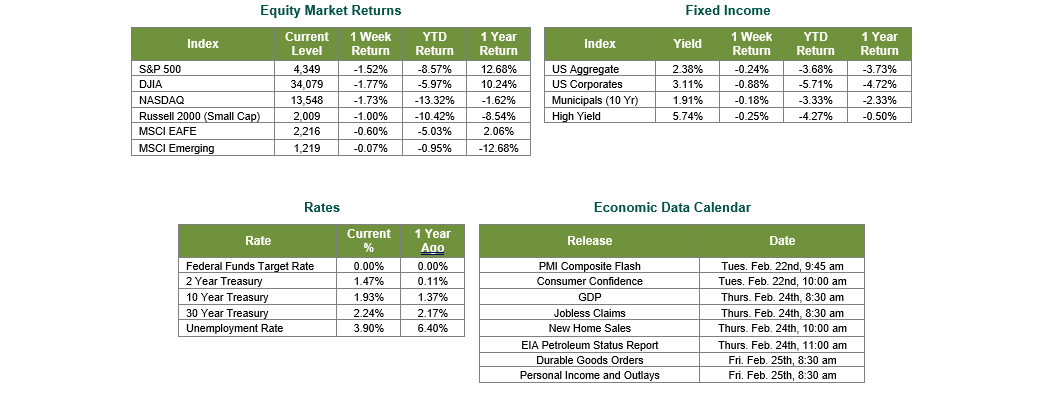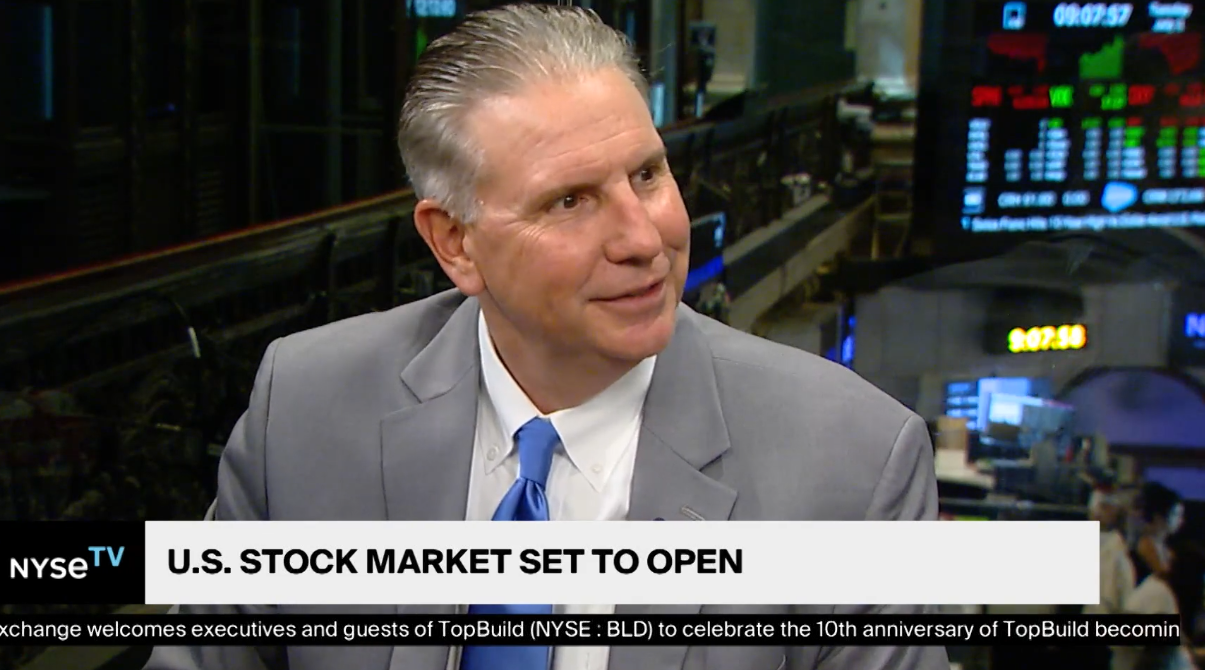
Last Week’s Markets in Review: Consumer Spending Strong Despite Declining Sentiment

Global equity markets moved lower last week with geopolitical uncertainties in focus. The S&P 500 closed the week at a level of 4,349, representing a loss of 1.52%, while the Russell Midcap Index moved 1.76% lower. Meanwhile, the Russell 2000 Index, a measure of the Nation’s smallest publicly traded firms, returned -1.00%. International equity performance struggled as developed and emerging markets returned -1.86% and -0.67%, respectively. Finally, the 10-year U.S. Treasury yield was flat over the week, closing at 1.92% on Friday.
The S&P 500 Index was initially able to buck the selling trend and moved higher early last week, but volatility continued to persist for the rest of the week. News of de-escalation of tension between Russia and Ukraine helped markets jump early in the week. However, it appears that the narrative may now be in doubt. While markets search for direction in 2022, we wanted to bring attention to the U.S retail sales report, which recently surprised to the upside in a meaningful way. The outperformance in retail sales, 3.8% month-over-month growth vs. 2.0% estimates, notably online shopping, may help reinvigorated confidence in the strength of the U.S. consumer.
The surge marks the biggest increase in 10 months and a sharp rebound from the downwardly revised December 2021 data, which was likely impacted by the rise in COVID-19 cases related to the Omicron variant. While economists point to the angst of rising prices driving the downward trend in consumer sentiment recently, shoppers remained resilient and continued to spend – at least for now. Below are some important components from the release.

The surge in nonstore retailer sales, even as overall health conditions improve and the holiday shopping season is over, underscores our conviction that the growth in e-commerce is part of a longer-term trend and not a pandemic era fad. It is also important to keep in mind that consumers demanding fast and easy buying options increase activity for many other industries, not just the e-tailers, and benefits the entire e-commerce ecosystem (hardware, software, payment processors, logistics, etc.). Elsewhere, furniture and vehicles came in strong. At the same time, restaurants and bars, the only services-oriented category in this report, fell in January as more consumers likely ate at home as the Omicron variant spread.
Moving forward, the strong sales number could mean upward revisions to GDP as consumption makes up for the majority of gross domestic product (GDP) in the U.S. When coupled with continued strength in company earnings and the potential for supply chain and hiring headwinds to alleviate over the course of the year, we remain constructive of equity growth potential for certain market areas in the face of an overall slowing economy and rising interest rate environment.
Working with experienced financial professionals can help investors navigate the complex capital markets to build and manage the asset allocations within their portfolio strategies consistent with their objectives, timeframe, and tolerance for risk.
Best wishes for the week ahead!
Sources for data in tables: Equity Market and Fixed Income returns are from JP Morgan as of 2/18/22. Rates and Economic Calendar Data from Bloomberg as of 2/18/22. International developed markets measured by the MSCI EAFE Index, emerging markets measured by the MSCI EM Index, U.S. Large Cap defined by the S&P 500. Sector performance is measured using the GICS methodology.
Disclosures: Past performance does not guarantee future results. We have taken this information from sources that we believe to be reliable and accurate. Hennion and Walsh cannot guarantee the accuracy of said information and cannot be held liable. You cannot invest directly in an index. Diversification can help mitigate the risk and volatility in your portfolio but does not ensure a profit or guarantee against a loss.
Diversification can help mitigate the risk and volatility in your portfolio but does not ensure a profit or guarantee against loss.
Investing in commodities is not suitable for all investors. Exposure to the commodities markets may subject an investment to greater share price volatility than an investment in traditional equity or debt securities. Investments in commodities may be affected by changes in overall market movements, commodity index volatility, changes in interest rates or factors affecting a particular industry or commodity.
Products that invest in commodities may employ more complex strategies which may expose investors to additional risks.
Investing in fixed income securities involves certain risks such as market risk if sold prior to maturity and credit risk, especially if investing in high yield bonds, which have lower ratings and are subject to greater volatility. All fixed income investments may be worth less than the original cost upon redemption or maturity. Bond Prices fluctuate inversely to changes in interest rates. Therefore, a general rise in interest rates can result in the decline of the value of your investment.
Definitions
MSCI- EAFE: The Morgan Stanley Capital International Europe, Australasia and Far East Index, a free float-adjusted market capitalization index that is designed to measure developed-market equity performance, excluding the United States and Canada.
MSCI-Emerging Markets: The Morgan Stanley Capital International Emerging Market Index, is a free float-adjusted market capitalization index that is designed to measure the performance of global emerging markets of about 25 emerging economies.
Russell 3000: The Russell 3000 measures the performance of the 3000 largest US companies based on total market capitalization and represents about 98% of the investible US Equity market.
ML BOFA US Corp Mstr [Merill Lynch US Corporate Master]: The Merrill Lynch Corporate Master Market Index is a statistical composite tracking the performance of the entire US corporate bond market over time.
ML Muni Master [Merill Lynch US Corporate Master]: The Merrill Lynch Municipal Bond Master Index is a broad measure of the municipal fixed income market.
Investors cannot directly purchase any index.
LIBOR, London Interbank Offered Rate, is the rate of interest at which banks offer to lend money to one another in the wholesale money markets in London.
The Dow Jones Industrial Average is an unweighted index of 30 “blue-chip” industrial U.S. stocks.
The S&P Midcap 400 Index is a capitalization-weighted index measuring the performance of the mid-range sector of the U.S. stock market, and represents approximately 7% of the total market value of U.S. equities. Companies in the Index fall between S&P 500 Index and the S&P SmallCap 600 Index in size: between $1-4 billion.
DJ Equity REIT Index represents all publicly traded real estate investment trusts in the Dow Jones U.S. stock universe classified as Equity REITs according to the S&P Dow Jones Indices REIT Industry Classification Hierarchy. These companies are REITs that primarily own and operate income-producing real estate.



